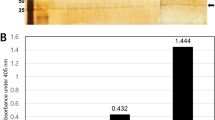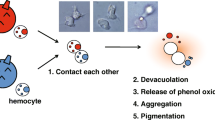Summary
Two distinct oligosaccharide ligands that function in both the allogeneic contact/cytotoxic reaction (ACR) by hemocytes and gamete fertilization were identified by means of the monoclonal antibodies (Mabs), CRB1 and CRB2, which inhibit both the ACR and fertilization in Halocynthia roretzi. The CRB1 epitope, determined to be the “core” α1–6 fucosylated oligosaccharide epitope (CFOE) in hybrid-type N-glycans, was detected on the cell surfaces of all types of hemocytes as well as on those of follicle cells and the vitelline coat of eggs. The CRB2 epitope, which was indicated as an outer-side sulfated and phosphorylated ojigosaccharide epitope (OSPOE) in complex-type N-glycans, was demonstrated on the cell surfaces of some types of hemocytes and egg follicle cells. Both epitopes, OSPOES and CFOE, may function as ligands in the initial attachment and binding, respectively, in the sperm-egg interaction. These epitopes may also function in the same way in the self-recognition of the ACR. We propose that the fucose residue in CFOE is among the key molecules, and perhaps the most important, involved in self-recognition in the ACR and fertilization.
Access this chapter
Tax calculation will be finalised at checkout
Purchases are for personal use only
Preview
Unable to display preview. Download preview PDF.
Similar content being viewed by others
References
Burnet FM (1971) “Self-recognition” in colonial marine forms and flowering plants in relation to the evolution of immunity. Nature 232:230–235
Dan-Sohkawa M, Morimoto M, Mishima H, Kaneko H (1995) Characterization of coelomocytes of the ascidian Halocynthia roretzi based on phase-contrast, time-lapse video and scanning electron microscopic observations. Zool Sei 12:289–301
De Santis R, Pinto MR, Cotelli F, Rosati F, Monroy A. G. D. A. (1983). A fucosyl glycoprotein component with sperm receptor and sperm-activating activities from the vitelline coat of Ciona intestinalis eggs. Exp Cell Res 148:508–514
Flajnik MF, Ohta Y, Namikawa-Yamada C, Nonaka M (1999). Insight into the primordial MHC from studies in ectothermic vertebrates. Immunol Rev 167:59–67
Fuke M (1990) Seifand nonself recognition in the solitary ascidian, Halocynthia roretzi. In:Marchalonis J, Reinish C (eds) Defense molecules. Allan R. Liss, Inc., New York, pp 107–117
Fuke MT (1980) “Contact reactions” between xenogeneic and allogeneic coelomic cells of solitary ascidians. Biol Bull 158:304–315
Fuke MT (1985) Pattern of cellular alloreactivity of the solitary ascidian, Halocynthia roretzi, in relation to genetic control. Biol Bull 169:631–637
Godknecht A, Honegger TG (1991) Isolation, characterization, and localization of a spermbound N- acetylglucosaminidase that is indispensable for fertilization in the ascidian, Phallusia mammillata. Dev Biol 143:398–407
Hoshi M (1986) Sperm glycosidase as a plausible mediator of sperm binding to the vitelline envelope in Ascidians. Adv Exp Med Biol 207:251–260
Humphreys T, Reinherz EL (1994) Invertebrate immune recognition, natural immunity and the evolution of positive selection. Immunol Today 15:316–320
Kao TH, McCubbin AG (1996) How flowering plants discriminate between self and non-self pollen to prevent inbreeding. Proc Natl Acad Sei USA 93:12059–12065
Magor BG, De Tomaso A, Rinkevich B, Weissman IL (1999) Allorecognition in colonial tunicates: protection against predatory cell lineages? Immunol Rev 167:69–79
Magor KE, Vasta GR (1998) Ancestral immunity comes of age. Immunol. Today 19:54–56
Oka H, Watanabe H (1957) Colony-specificity in compound ascidians as tested by fusion experiments. Proc Japan Acad Sei 33:657–659.
Watanabe H (1962). Studies on the regulation in fused colonies in Botryllus primigenus (Ascidiae Compositae). Sei. Rep. Tokyo Bunrika Daigaku 10B, 253–284.
Author information
Authors and Affiliations
Editor information
Editors and Affiliations
Rights and permissions
Copyright information
© 2001 Springer Japan
About this chapter
Cite this chapter
Arai, M., Ohtake, SI., Ohba, H., Tanaka, K., Chiba, J. (2001). Common Cell Surface Ligands Functioning in Allogeneic Cytotoxic Reaction and Fertilization in Halocynthia roretzi . In: Sawada, H., Yokosawa, H., Lambert, C.C. (eds) The Biology of Ascidians. Springer, Tokyo. https://doi.org/10.1007/978-4-431-66982-1_62
Download citation
DOI: https://doi.org/10.1007/978-4-431-66982-1_62
Publisher Name: Springer, Tokyo
Print ISBN: 978-4-431-66984-5
Online ISBN: 978-4-431-66982-1
eBook Packages: Springer Book Archive




